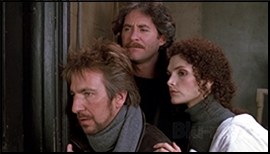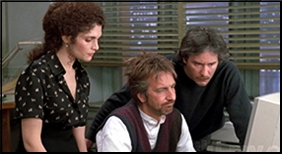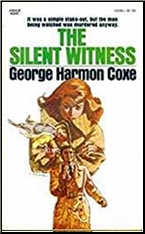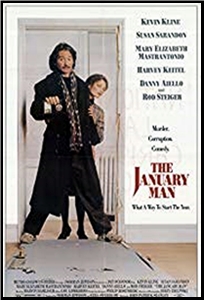REVIEWED BY DAN STUMPF:
THE JANUARY MAN. MGM, 1989. Kevin Kline, Mary Elizabeth Mastrantonio, Susan Sarandon, Hervey Keitel, Danny Aiello, Rod Steiger, Alan Rickman. Written by John Patrick Shanley. Directed by Pat O’Connor.

You have been unjustly fired from a job you did well, and now your ex-employers, faced with a crisis only You can handle, come crawling to ask you back. Along the way they almost interrupt you in a casual act of heroism, but you take the job, whereupon the Red Carpet is rolled out, you meet a sexy young girl who falls madly in love with you, your ex-girlfriend suddenly wants you back, and everybody who ever talked nasty to you is now at your beck and call.
And wouldn’t it be great if they all brought Chocolate?

Well, I suppose there are worse male fantasies, and although The January Man is neither as suspenseful as it should be nor as amusing as it could be, it still deserves some credit for realizing its limited aspirations in a light-hearted and relatively non-violent way. In fact, for a movie about a serial killer of women, it’s surprisingly un-sadistic in concept and execution (no pun intended — honest.)
The January Man also offers some decent thespic opportunities to its performers, who try not to look too surprised at getting them. Kevin Kline is engagingly off-beat as the Cop-turned-Fireman Hero called back to solve the Calendar Girl Murders; Danny Aiello and Rod Steiger are appropriately choleric as his superiors, and Susan Sarandon purveys her own brand of predatory sexuality as Kline’s ex-sweetie. Best of all is Alan Rickman, looking more than ever like a young Vincent Price, as the Maynard Krebbs to Kline’s love-happy Dobie Gillis.
Two things I noticed about this on repeated viewing:

First, perhaps because of budget and scheduling restrictions, the big stars in this are seldom on screen at the same time, even when they have scenes together. Director Pat O’Connor keeps shooting important confrontations with his camera on one actor, looking over the back of (probably) a double: A shouting match between Aiello and Steiger, an emotional moment between Kline and the woman who sold him out (Sarandon) and a particularly sticky encounter between Sarandon and Kline’s new love (Mastrantonio) in his apartment — all done with stand-ins, but emoted quite well.
Secondly, I’m not sure quite what effect the movie was trying for with the( literally) knock-down-drag-out fight at the end, a mix of brutal action and bemused commentary, but it worked for me. In a movie era of obsessed cops and loathsome killers, it was refreshing to see things capped off with an exciting but light-hearted set-to, and I’m glad someone thought of it.




